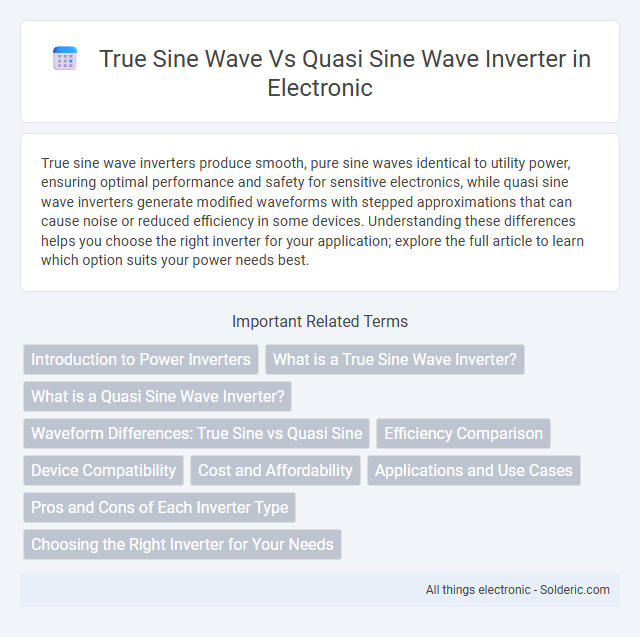True sine wave inverters produce smooth, pure sine waves identical to utility power, ensuring optimal performance and safety for sensitive electronics, while quasi sine wave inverters generate modified waveforms with stepped approximations that can cause noise or reduced efficiency in some devices. Understanding these differences helps you choose the right inverter for your application; explore the full article to learn which option suits your power needs best.
Comparison Table
| Feature | True Sine Wave Inverter | Quasi Sine Wave Inverter |
|---|---|---|
| Wave Output | Pure, smooth sine wave | Modified, stepped sine wave |
| Compatibility | Compatible with all AC devices | Limited compatibility; not suitable for sensitive electronics |
| Efficiency | High efficiency with stable output | Moderate efficiency, possible voltage spikes |
| Cost | Higher cost | Lower cost |
| Applications | Medical equipment, audio/video devices, sensitive electronics | Basic appliances like fans, lights, and power tools |
| Output Quality | Clean output with minimal harmonic distortion | Higher harmonic distortion, may cause noise and heat |
Introduction to Power Inverters
True sine wave inverters produce smooth, consistent electricity by replicating the natural sine wave output of the grid, ensuring compatibility with sensitive electronics and appliances. Quasi sine wave inverters generate a modified or stepped waveform that may cause noise, reduced efficiency, or potential damage to delicate devices. Choosing the right inverter for your needs ensures optimal performance and longevity of your electrical equipment.
What is a True Sine Wave Inverter?
A True Sine Wave Inverter produces electrical output that closely matches the smooth, consistent waveform of utility-supplied electricity, ensuring compatibility with sensitive electronics and appliances. Unlike Quasi sine wave inverters, which generate a stepped or modified waveform, True Sine Wave inverters minimize harmonic distortion and reduce noise interference. This makes them ideal for medical equipment, audio devices, and motors requiring clean, stable power.
What is a Quasi Sine Wave Inverter?
A Quasi Sine Wave Inverter produces a waveform that approximates a sine wave but consists of stepped or squared waveforms rather than a smooth curve, resulting in less efficient and noisier power output. This type of inverter is cheaper to manufacture and suitable for simple electronic devices like lamps or small fans but may cause compatibility issues or damage with sensitive electronics such as computers or medical equipment. True sine wave inverters, in contrast, generate a clean, smooth waveform identical to utility power, ensuring reliable performance for all types of electrical appliances.
Waveform Differences: True Sine vs Quasi Sine
True sine wave inverters produce a smooth, continuous waveform identical to grid power, ensuring compatibility with sensitive electronics and reducing noise or malfunctions. Quasi sine wave inverters generate a stepped, approximated waveform that may cause humming in motors, reduced efficiency, and potential damage over time to sensitive devices. Understanding these waveform differences helps you select the best inverter for reliable, high-quality power output tailored to your equipment's requirements.
Efficiency Comparison
True sine wave inverters deliver higher efficiency by producing a smooth and consistent AC output closely matching utility power, minimizing harmonic distortion and reducing energy losses in sensitive electronics. Quasi sine wave inverters generate a modified waveform that can cause increased heat generation and inefficiency in devices reliant on pure sine wave input, leading to potential performance degradation. Studies show true sine wave inverters typically achieve efficiency rates around 85-95%, whereas quasi sine wave models often fall below 80%, particularly under varied load conditions.
Device Compatibility
True sine wave inverters provide clean, consistent power that closely mimics utility grid electricity, ensuring full compatibility with sensitive electronics like medical devices, audio equipment, and induction cooktops. Quasi sine wave inverters produce a modified waveform that can cause overheating, reduced efficiency, or malfunction in devices requiring pure sine wave input. Choosing a true sine wave inverter guarantees your devices operate safely and efficiently without risk of damage or performance issues.
Cost and Affordability
True sine wave inverters typically cost more due to their advanced technology that produces smooth and consistent power output, making them ideal for sensitive electronics and high-performance appliances. Quasi sine wave inverters are more affordable but may cause interference or reduce the lifespan of certain devices because their output is less pure. Your choice depends on budget constraints and the specific power quality requirements of your equipment.
Applications and Use Cases
True sine wave inverters are ideal for sensitive electronic devices, medical equipment, and high-performance appliances requiring clean and stable power, ensuring efficient operation and protecting from potential damage. Quasi sine wave inverters suit simpler applications like power tools, lighting, and basic household electronics where minor waveform distortions do not affect performance significantly. Your choice depends on the critical nature of the devices you intend to power and their tolerance to waveform quality.
Pros and Cons of Each Inverter Type
True sine wave inverters provide pure, smooth power ideal for sensitive electronics, ensuring compatibility and minimal electrical noise, but generally come at a higher cost and larger size. Quasi sine wave inverters offer a more affordable, compact solution suitable for simple appliances but can cause humming, overheating, or reduced efficiency in complex devices. Your choice depends on the specific power quality requirements and budget constraints of your application.
Choosing the Right Inverter for Your Needs
True sine wave inverters deliver clean, stable electrical output identical to utility power, making them ideal for sensitive electronics, medical equipment, and appliances requiring precise operation. Quasi sine wave inverters, while more cost-effective, produce a modified waveform that may cause noise or reduced efficiency in certain devices such as audio equipment or motors. Selecting the right inverter depends on the type of load, budget constraints, and the need for compatibility with sensitive electronics to ensure optimal performance and longevity.
True sine wave vs Quasi sine wave inverter Infographic

 solderic.com
solderic.com